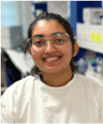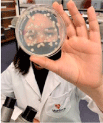ASM Summer Student Research Awards: 2022
Priscilla Johanesen AA Chair, ASM Standing Committee for Professional Development.
Microbiology Australia 43(3) 137-140 https://doi.org/10.1071/MA22043
Published: 2 September 2022
© 2022 The Author(s) (or their employer(s)). Published by CSIRO Publishing on behalf of the ASM. This is an open access article distributed under the Creative Commons Attribution-NonCommercial-NoDerivatives 4.0 International License (CC BY-NC-ND)

|
The Australian Society for Microbiology is committed to supporting the future generations of Microbiology researchers. One of the ways in which ASM is able to support our early career-stage microbiologists is through the ASM Summer Student Research Awards, which provide opportunities for students to work on short research projects across the summer period. This year the society awarded 12 ASM Summer Student Research Awards across Australia. The successful awardees were: Valentin Slesarenko and Kellynn Tan from Queensland; Maia Perry from South Australia; Nicholas Slamen from Tasmania; Isni Buthgamuwa, Rylee Deehan, Nhu Quynh Doan and Desirel Ng from Victoria; Emma Catchpole, Dávid Szabó, Vanessa Tenaglia and Crystal Young from Western Australia. The ASM would like to offer our warmest congratulations to all of our 2022 Summer Student Research Awardees, and we look forward to supporting them in other ways as their careers in Microbiology progress.
Queensland
Pneumococcal strain characterisation in children

|
Valentin Slesarenko, Taha, Jessica Brown and Kate L. Seib
Institute for Glycomics, Griffith University, Queensland, Queensland, Australia
Abstract: Streptococcus pneumoniae is one of the most common bacterial pathogens responsible for acute respiratory tract infections. This research project aimed to determine the sequence types (STs) within a subset of pneumococcal-positive nasal swabs taken from children at weekly intervals, using multilocus sequence typing (MLST). We discovered that pneumococcal STs tend to be persistent over time, whereas a shift between STs is possible but rare. These findings improve our current understanding of the pneumococcal strains involved in colonisation and disease. This may aid the future development of antibiotics and vaccines to reduce the global burden of pneumococcal disease.
Counteracting antibody-mediated serum resistance

|
Kellynn K. Y. Tan and Timothy J. Wells
Diamantina Institute, The University of Queensland, Brisbane, Queensland, Australia
Abstract: Pseudomonas aeruginosa is an important nosocomial pathogen which causes acute infections that commonly lead to bloodstream infections (BSI) and sepsis. Clinical management is problematic due to intrinsic and acquired resistance to many antibiotics. Complement-mediated killing (serum killing) is one of the major ways the immune system combats Gram-negative infections. Antibodies usually promote serum-killing; however, a sub-set of patients with P. aeruginosa infection produce specific antibodies that protect bacteria from serum-killing. These ‘cloaking antibodies’ (cAb) belong to the IgG2 or IgA subclass and target lipopolysaccharide on the bacterial surface. Importantly, the presence of cAbs correlates with worse outcomes in bronchiectasis and lung transplants and was identified in 14% of patients with P. aeruginosa BSI. Methods to counteract this antibody-mediated protection would allow the immune system to quickly kill these pathogens regardless of multi-drug resistance. The LPS-binding antibiotic Polymyxin-B (PmB) and its derivative nonapeptide (PMBN), can sensitise innately serum-resistant bacteria to serum-killing. However, it is unknown whether these molecules could counteract serum resistance by cAb. We tested whether PmB or PMBN treatment of P. aeruginosa clinical isolates will counteract cAb serum-protection. We found that although these molecules do sensitise bacteria to healthy serum killing, it does not affect serum resistance mediated by cAbs.
South Australia
The transfer of antimicrobial resistance plasmids between bovine respiratory disease pathogens via liquid conjugation and electroporation

|
Maia Perry, Abiodun David Ogunniyi and Darren Trott
Australian Centre for Antimicrobial Resistance Ecology, School of Animal and Veterinary Sciences, The University of Adelaide, Adelaide, South Australia, Australia
Abstract: Bovine respiratory disease (BRD) is the leading cause of death in feedlot cattle, resulting in economic losses of an estimated A$40 million annually. This significant loss makes BRD a substantial concern for the cattle industry. Due to the use of antibiotics for prophylaxis and metaphylaxis against BRD, antimicrobial resistance and the transfer of resistance genes needs to be carefully observed. Two Pasteurella multocida isolates, exhibiting resistance to macrolides or β-lactams, and four Mannheimia haemolytica isolates, resistant to macrolides or sensitive, were subject to liquid mating and electroporation experiments. Neither liquid mating nor electroporation experiments were successful. Although growth was observed on SBA plates, no colonies of the desired species were observed on antibiotic selective plates. It is unknown why the macrolide resistance plasmid could not be transferred into either P. multocida or M. haemolytica via either method used, however previous research has been successful in using P. multocida in both experiments. Liquid mating was only attempted using a M. haemolytica donor, and it would be beneficial to conduct it again, using a P. multocida donor. Knowledge gained from future research could be vital in understanding the spread of resistance among BRD pathogens.
Tasmania
Characterising the DinB (DNA polymerase IV)-dependent mutation generation pathway in Pseudomonas aeruginosa

|
Nicholas Slamen and Mark Ambrose
The Tasmanian School of Medicine, University of Tasmania, Tasmania, Australia
Abstract: Pseudomonas aeruginosa is an important human opportunistic bacterial pathogen whose infections are difficult to eradicate because of its intrinsic resistance to various classes of commonly available antibiotics, as well as its ability to generate resistance mutations during relevant treatment regimens. Here, the role of the damage-inducible SOS-controlled error-prone DNA polymerase IV (DinB) in generating ciprofloxacin-resistance mutations in stationary phase bacterial cells was investigated. The overall numbers of ciprofloxacin resistant (CipR) mutants able to be recovered under conditions of selection were greatly reduced when the bacterial cells concerned carried a defective dinB gene. Importantly, the yields of CipR mutations recovered in dinB-defective cells could be elevated to levels approaching wild-type when they were supplied with the dinB gene on a low-medium copy number plasmid, but not when they were made to overexpress either of the SOS-response recA or imuC (DNA polymerase ImuC) genes; in turn, suggesting that DNA polymerase IV is one of the main SOS regulated error-prone polymerases responsible for generating ciprofloxacin-resistance mutations in stationary phase P. aeruginosa cells. In addition, the full operation of the DNA polymerase IV-dependent mutation generation pathway in part at least required sufficient cellular levels of the bacterial general stress response sigma factor σs, RpoS. Collectively, these data improve our understanding of the cellular processes likely controlling the expression of the DNA polymerase IV (DinB)-dependent mutation generation pathway operating in stationary phase P. aeruginosa cells and highlight possible cellular targets for therapeutic intervention.
Victoria
The stability of the short-beaked echidna’s microbiome through gestation

|
Isni Buthgamuwa, Ashley Dungan and Linda Blackall
The School of BioSciences, University of Melbourne, Melbourne, Victoria, Australia
Abstract: The short-beaked echidna, Tachyglossus aculeatus, is a cherished and iconic native Australian animal and is one of five currently existing monotremes. Having diverged from Eutherian/placental mammals roughly 184 million years ago, monotremes have evolved unique reproductive strategies, specifically egg laying. The composition of the gut microbiota of female mammals is quite important, as it provides an opportunity for vertical transmission of microbes to offspring as well as maintaining foetus health. Very little is known about the composition and role of the echidna microbiome, hence, this study aims to characterise the gut microbiome of female short-beaked echidnas and gain better understanding of the changes that may occur in their microbiome as they go through pregnancy. Faecal samples from four female and five male echidnas were obtained from the Currumbin Wildlife Sanctuary and underwent DNA extraction, with the V4-V5 region of the bacterial 16S rRNA gene amplified for metabarcoding. While some bacteria were unique to sections of the gestation cycle, overall, the bacterial community composition was not significantly different between reproductive stages. Furthermore, the study is the first to describe the microbiome composition of both female and male echidnas.
Harnessing experimental evolution for bacteriophage therapy of Enterobacter cloacae complex infections

|
Rylee A. Deehan and Jeremy J. Barr
School of Biological Sciences, Monash University, Melbourne, Victoria, Australia
Abstract: Antibiotic resistance is arguably the greatest public health challenge of the 21st century. Immediate action is required to overcome this challenge. Bacteriophages (phages) are viruses that kill bacteria. The therapeutic use of phages, known as bacteriophage therapy, could be crucial in combatting antibiotic-resistant bacterial pathogens. However, a major issue is phages are often poorly adapted to clinical bacterial isolates. Fortunately, experimental evolution can improve therapeutic phages. Here, I experimentally evolved two ancestral phages against eight clinical antibiotic-resistant Enterobacter cloacae complex strains to produce novel evolved phages with enhanced killing efficiencies. Bacterial growth curves and derived phage scores, which range from 0 (no reduction in bacterial growth) to 1 (full reduction in bacterial growth), were completed to assess the phage’s killing efficiencies. Six of the 16 evolved phages had between 1.3 and 4.3-fold increase in their killing efficiency on their evolution host when compared with the ancestral phage. Additionally, one of the evolved phages gained the ability to effectively kill its evolution host, with a phage score of 0.76 compared with 0 for the ancestral phage. Going forward, enhancing the killing efficiency of therapeutic phages via harnessing experimental evolution may be key to the enduring success of bacteriophage therapy.
Investigating the mechanisms of H2 production and consumption in the human gastrointestinal tract

|
Nhu Doan, Caitlin Welsh, Rachael Lappan and Chris Greening
Department of Microbiology, Monash Biomedicine Discovery Institute, Monash University, Melbourne, Victoria, Australia
Abstract: Hydrogen gas in the human gastrointestinal tract (GIT) is exclusively produced by the gut microbiota. Given that H2 gas is linked with a variety of human disorders, our current understanding of H2 cycling is limited. Therefore, this study aims to investigate the hydrogenogenic activity of human GIT bacteria that contain the Group B [FeFe]-hydrogenase. Recent research, based on sequence and phylogeny similarities to the Group A1 [FeFe]-hydrogenase, has predicted that the Group B [FeFe]-hydrogenase may play a hydrogenogenic role in the GIT; however, there is currently no experimental evidence to confirm this prediction. Seven Bacteroides species were tested for their H2 production capability, in which all species produced large amounts of H2, providing support that the Group B [FeFe]-hydrogenase is responsible. Additionally, Bacteroides caccae and Bacteroides faecis showed significant declines in H2 concentration from day 2 of growth. This finding suggests that the Group B [FeFe]-hydrogenase may operate in a reversible manner, depending on the availability of organic sources.
Inhibiting Clostridioides difficile PBPx mediated resistance to sporulation inhibition

|
Desirel Ng, Yogitha N. Srikhanta and Dena Lyras
Department of Microbiology, Monash Biomedicine Discovery Institute, Monash University, Melbourne, Victoria, Australia
Abstract: Clostridioides difficile infection (CDI) is the leading cause of nosocomial diarrhoea worldwide and is perpetuated by C. difficile spores; however, no cost-effective treatments target spores. Our previous work showed that the β-lactam cephalosporin, cefotetan, can reduce C. difficile sporulation by inhibiting the spore penicillin-binding protein (spore-PBP), CdSpoVD, which is essential for spore peptidoglycan synthesis. However, some C. difficile animal isolates have acquired an accessory spore-PBP, PBPx, which maintains sporulation in the presence of cefotetan, highlighting the need for strategies that can also target PBPx+ strains. Here, we determined if the PBP inhibitor, DN1, could block the activity of PBPx and reduce sporulation in the PBPx+ animal isolate, CdAs, by performing sporulation assays and identifying its PBP targets using PBP profiles. DN1 was found to reduce spore numbers completely on day 1 and by 2150-fold on day 2 by targeting cefotetan-induced PBPx. These results suggest that DN1 may be a viable route to expanding our anti-sporulation strategy to C. difficile PBPx+ strains and potentially improve CDI treatment by reducing spores.
Western Australia
An investigation into the prevalence of commensal Neisseria spp. and the co-carriage of commensal Neisseria spp. with N. meningitidis and N. gonorrhoeae

|
Emma Catchpole, August Mikucki and Charlene Kahler
The Marshal Center for Infectious Disease Research and Training, School of Biomedical Science, University of Western Australia, Perth, Western Australia, Australia
Abstract: The Neisseria genus is comprised of 10 species capable of inhabiting human mucosal surfaces. Two of these species are pathogenic: N. meningitidis, which causes invasive meningococcal disease in susceptible patients, and N. gonorrhoea, which causes the sexually transmitted disease gonorrhoea. The remaining eight species are considered commensal. In recent years, studies have suggested commensal Neisseria species may have an inhibitory effect on the pathogenic species. This study used qPCR to investigate the carriage of commensal and pathogenic Neisseria species in oropharyngeal samples collected in a previous study in the Pilbara, Western Australia. The results indicate co-carriage of both N. meningitidis and N. gonorrhoea with commensal N. mucosa and N. subflava. Validation of the primers used, and the early design of a N. lactamica-specific primer was also carried out, which highlighted the challenges of creating commensal species-specific qPCR primers. This study provides exciting early insight into the prevalence of commensal Neisseria species and also the relationship between commensal and pathogenic Neisseria species.
Does the stringent response prime mobile genetic elements for horizontal gene transfer?

|
Dávid Szabó, Elena Colombi and Joshua Ramsay
Curtin Health Innovation Research Institute, Curtin University, Perth, Western Australia, Australia
Abstract: Integrative and conjugative elements (ICEs) are a type of mobile genetic element that allow the transfer of nitrogen-fixation capability from Mezorhizobium sp. to non-symbiotic soil bacteria. In M. japonicum strain R7A, ICEMlSymR7A normally has a low rate of horizontal transfer. However, ICEMlSymR7A can stimulate epigenetic differentiation of R7A cells into a subpopulation termed R7A*, which exhibits enhanced ICE conjugation and is activated for quorum sensing and production of N-acyl homoserine lactones (AHLs). Details concerning the induction and maintenance of this state remain unclear, though RNA sequencing of R7A* cells has revealed downregulation of numerous ribosomal subunit genes, potentially implicating the amino acid starvation-triggered ‘stringent response’. In this study, we investigated a potential role of the stringent response in R7A* differentiation by constructing mutations in the (p)ppGpp synthetase/hydrolase gene spoT. Deletion of spoT could not be achieved, suggesting the gene may be essential in M. japonicum. However, an insertion mutation in a spoT regulatory domain exhibited decreased AHL synthesis, suggesting the stringent response is at least indirectly involved in maintenance of the R7A* state. We also established that R7A* differentiation could not be stimulated by paraquat-induced oxidative stress or by the ribosome-inhibiting antibiotic kasugamycin.
Adapting nasopharyngeal bacteria to synthetic nasal medium

|
Vanessa Tenaglia, Mark Nicol and Ritika Kar Bahal
Marshall Centre for Infectious Diseases Research and Training at The University of Western Australia, Perth, Western Australia, Australia
Abstract: The nasopharyngeal environment supports a diverse community of microorganisms. Maturation of the bacterial microbiome of the nasopharynx over the first year of life is characterised by succession of different bacterial taxa, and aberrant maturation has shown to negatively affect respiratory health in children. The objective of this study was to use synthetic nasal medium (SNM) to mimic the nasopharyngeal environment and to grow nasopharyngeal bacteria in this medium. Bacterial strains cultured from nasopharyngeal swabs of infants were successfully adapted to and propagated in SNM. Colony forming unit (CFU) fold changes after growth in SNM were nearly 500-fold for Staphylococcus epidermidis and over 7000-fold for Staphylococcus aureus after 40 h. Growth of Moraxella catarrhalis, Moraxella osloensis, Moraxella lincolnii, Corynebacterium propinquum and Haemophilus influenzae in SNM was substantially slower. This study highlights that SNM, which was originally developed to mimic the metabolic environment of the anterior nares, is well-suited to support growth of Staphylococci but may need further adaptation to better simulate the nasopharyngeal environment and support optimal growth of other members of the nasopharyngeal flora.
Production of the keto-carotenoid astaxanthin in Dunaliella salina via heterologous expression of codon-optimised β-carotene hydroxylase and ketolase

|
Crystal YoungA, Navid MoheimaniB, Damian LairdB and Wayne ReeveA
ABioplastic Innovation Hub, Food Futures Institute, Murdoch University, Perth, Western Australia, Australia
BCentre for Water Energy and Waste, Harry Butler Institute, Perth, Western Australia, Australia
Abstract: Astaxanthin, a highly valuable keto-carotenoid antioxidant, is currently produced in Haematococcus lacustris, but production is limited by β-carotene precursor availability. In contrast, Dunaliella salina produces the highest amount of β-carotene but cannot naturally produce astaxanthin. Here, we report the development of a chloroplast integration vector to express H. lacustris β-carotene ketolase (Brt) and hydroxylase (CrtZ) astaxanthin biosynthetic enzymes in D. salina. D. salina (MUR08) was isolated from Rottnest Island, Western Australia and used as a photosynthetic chassis for vector integration. MUR08 was unable grow on the surface of solid laboratory media but this was rectified using Ramaraj Media containing 15% glycerol overlaid with seeded agar overlays or by spreading cells over cellulose nitrate filter papers overlays. The growth of MUR08 enabled the brt-crtZ genes to be integrated into the chloroplast using microparticle bombardment. The work described provides an important foundation to deliver novel heterologous genes into a defined locus in the chloroplast genome of D. salina without disrupting cell growth.


